The team of authors led by Martin Jelínek from the High Energy Astrophysics Working Group of the AI Stellar Department studied an interesting gamma-ray burst registered by the INTEGRAL satellite instruments and subsequently followed in optical wavelenghts by a ground-based telescopes. The researchers focused on a study of an unusual flash GRB 190919B recorded by the IBAS instrument on the INTEGRAL satellite shortly before midnight on September 19, 2019. The authors analyze the observations in detail and show that the flash and the subsequently observed optical afterglow are probably the result of two different physical processes.
Gamma-ray bursts are undoubtedly the brightest isolated events that usually occur at cosmological distances. The amount of released energy usually exceed 1047 W, the flashes last in a wide range of timescales from fractions of a second to tens of thousands of seconds and are a unique source of a gamma radiation of very high energy . Gamma-ray burst is often followed by shorter wavelength afterglow of electromagnetic radiation, including the visible and infrared. This phenomenon is generally thought to be caused by a catastrophic event, such as the collapse of a massive star when a type II supernova ignites or the collision of compact objects – neutron stars or black holes.
- more about the work at AI webpage: Michal Švanda, Na čem pracujeme: Gama záblesk s neobvyklým optickým dosvitem (in Czech)
- scientific paper: M. Jelínek, M. Topinka et al., GRB 190919B: Rapid optical rise explained as a flaring activity, Astronomy & Astrophysics, ina press, preprint arXiv:2203.11059
- contakt: Mgr. Martin Jelínek, Ph.D.



